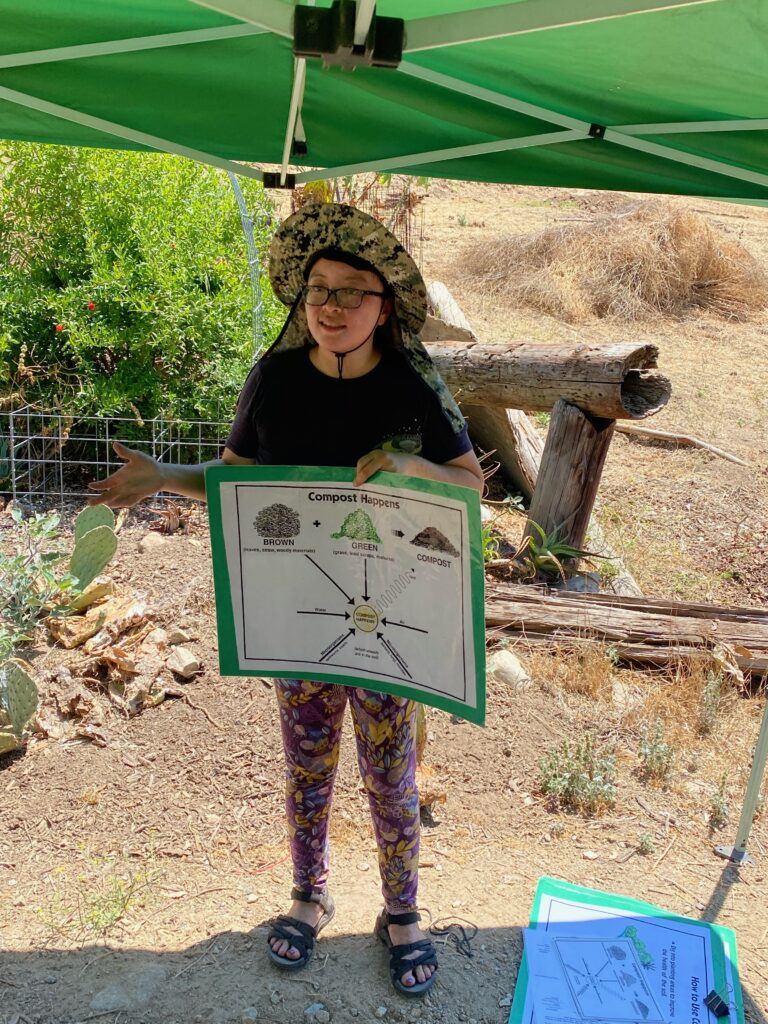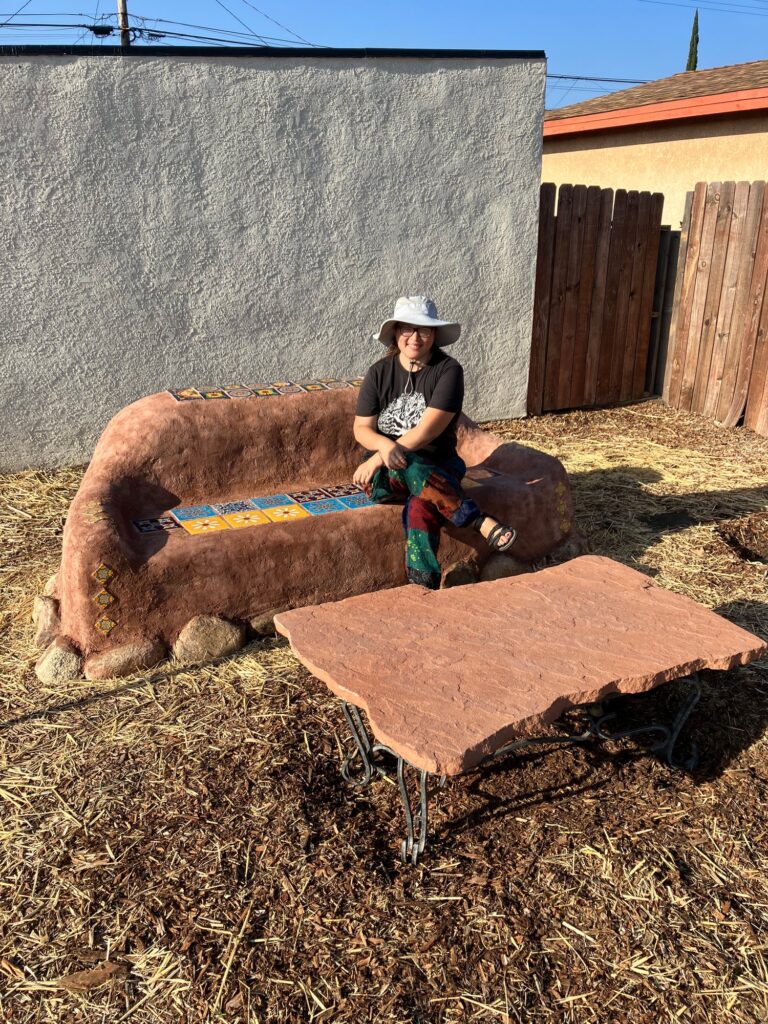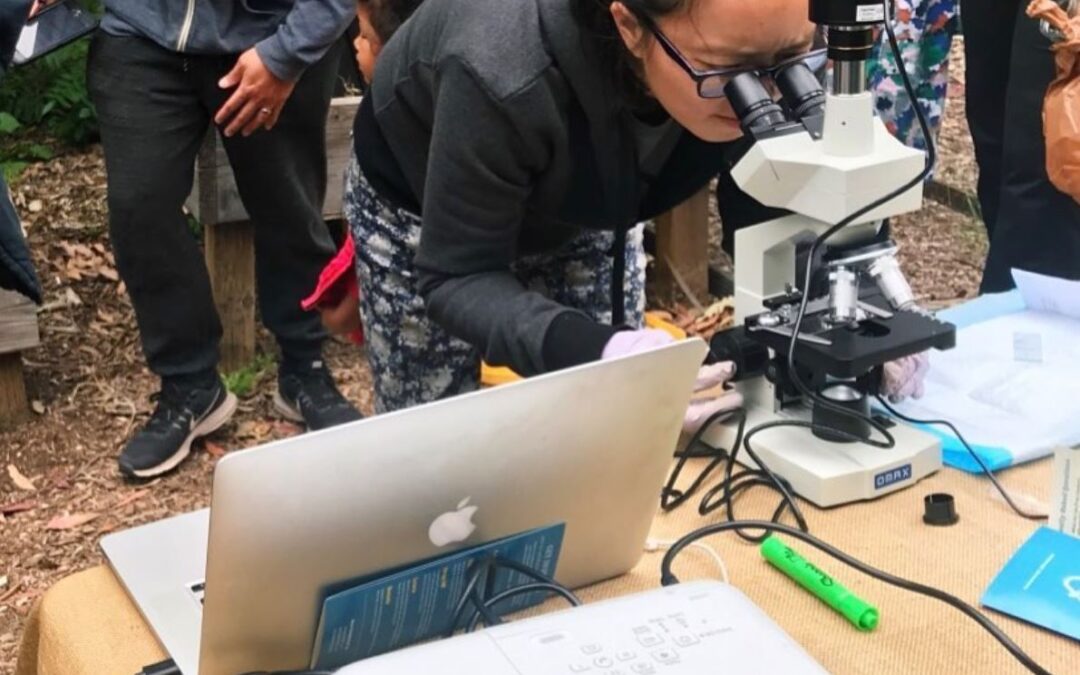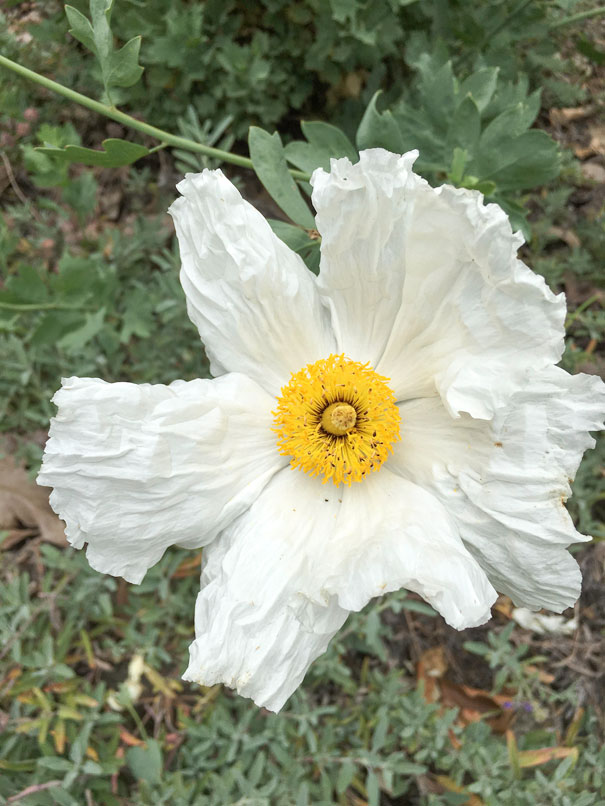This interview with Lynn Fang, MS has been edited for length and clarity. (AJPJ)
Lynn Fang is a soil scientist with over 10 years of experience in ecological landscape design, soil science, community composting, and regenerative farming. She centers on soil health as the foundation of thriving and abundant gardens. She is an adjunct professor at Pitzer College and works with LA Compost and ECOFARM. She has also worked with Metabolic Studio, Studio Petrichor, the LA County Arboretum Crescent Farm, CropSwapLA, Buena Vista Community Garden (now Gente Community Garden), and Huerta del Valle.
AJ: What is your background in soil science and how did you get interested in it? I know it’s a hot topic in the era of climate change. But I suspect that when you were starting out, it was not.
LF: Right? I didn’t really think about soil or gardening growing up. I didn’t come from a farming family or anything like that. I had a pretty conventional suburban upbringing in the Bay Area.
I didn’t start thinking about soil and related topics until the very end of college! Honestly, it was probably the last course that I took at UC Berkeley – a general education class that I took just to fulfill my last requirement. I was trying to get into some other class, but it was waitlisted. So it was totally random that I ended up taking this class “International Rural Development.”
The class ended up being about Monsanto, chemical agriculture, and green revolution policies.
I was already on this path of activism and thinking about whether I really wanted a corporate job. I wanted to make a difference in the world … and that class really opened my mind…
AJ: Had you already been thinking about environmental activism?
I had started thinking about environmental issues a bit. Another professor of mine, Tyrone Hayes, was an endocrinologist working on frogs. At the very end of his class, he told us a story about how he had been funded to perform a study for a major agricultural chemical company. The data showed that one of this company’s signature products had an negative impact on frog reproduction, and they were trying to force him to reinterpret his data.
It led to a sort of serious war between him and this company – using espionage and stuff like that. And I was inspired by his story of standing up for what he believed in.
After college, I set off on a self education journey. I got involved with community gardens and ended up doing my Master’s degree at the University of Vermont on soil and compost ecology.
AJ: How long were you studying soils in Vermont?
Around three years. I didn’t want to stay in academia. I wanted to take what I had learned and apply it in the field and for the community. So I ended up coming back to California and doing community compost work. I started a community compost project in Pomona in 2015 at Sarvodaya Farms and everything has just grown from there.
 AJ: You also own a business, right?
AJ: You also own a business, right?
LF: I launched SoilWise maybe a year and a half ago. With SoilWise, I do landscaping with my partner, Ricky Martin, and some other landscaping friends. I also do soil health education and consulting. We are starting a small-scale pilot project producing high quality compost and soil blends. Unfortunately, the site I was launching at has been burned down.
AJ: I’m very sorry. We’ll come back to the fire in a moment, but I know you are also teaching a class!
LF: Yes, I am teaching an online course through my friend James McSweeney’s platform. He’s the author of a book called Community Scaled Composting Systems, and he launched an online course platform called The 131° School of Composting.
The class is SoilWise Microbial Assessment Certificate, and it is launching this month. People can still enroll, and it will be available through April. It is an in-depth introduction to identifying and interpreting microbes in soil or compost using a microscope. Students will also learn what the presence of different microbes means for their compost quality or soil health.
AJ: On the topic of compost, why should anyone want to compost? As you are aware … composting can be work. You have to stick your food scraps in a separate container. You have to add them to a pile or bin or walk them to the farmers market for drop off …
[the interviewer is pretty sure LF gave him a puzzled look]
LF: It can be work.
AJ: And it doesn’t stop there! If you’re composting yourself and not outsourcing the labor, there are also a whole bunch of chores to do …
LF: Well, one reason people get involved with composting is that they are anxious about the climate crisis – they want to do something. And composting is a pretty easy way to reduce your greenhouse gas emissions.
When you put food scraps or plant trimmings in the landfill, they release quite a bit of methane during anaerobic [low oxygen] decomposition. This is a problem, because methane is a really powerful greenhouse gas. It is 20 or 30 times as potent as CO2 in warming the atmosphere. Aerobic composting, [which incorporates a lot of oxygen] on the other hand, releases far less methane during the decomposition process. So composting – as opposed to letting food scraps putrefy in the landfill – decreases your warming impact.
By composting, you’re reducing methane emissions by reducing waste going to the landfill. And once your compost is finished and spread on the soil, it’s also going to increase the soil’s ability to sequester carbon. So it has a dual function in mitigating climate change by reducing methane emissions and increasing soil carbon sequestration.
AJ: How does adding compost to the soil increase carbon sequestration?
LF: To put it simply, it is going to increase the soil’s organic matter content.
In our ordinary language, the word “organic” is used in different ways. “Organic matter” can refer to anything from fresh leaf litter and food scraps to stable organic matter–what you might call humus. Humus is stable decomposed soil aggregates that contain a lot of carbon.
Adding compost to the soil helps create humus. And the more we create, the more carbon [hence, CO2] we will keep out of the atmosphere.
 AJ: Does that mean that this stable organic matter in the soil is no longer decomposing? Or at least not decomposing as fast?
AJ: Does that mean that this stable organic matter in the soil is no longer decomposing? Or at least not decomposing as fast?
LF: Not as actively. There’s actually a lot of research that says fungi are more efficient [than bacteria] at incorporating fresh organic carbon into stabilized and protected carbon in the soil. So fungi are better at sequestering carbon, because they’re better at building these soil aggregates. Bacteria are more likely to use the carbon and respire CO2.
That’s partly why it’s good to encourage more fungi in the soil, because it will help to build up that soil structure and so protect the sequestered carbon.
AJ: Okay, let me try to summarize. Firstly, composting reduces potent greenhouse gas emissions from food waste and plant trimmings in landfills. I guess, relatedly, it’s beneficial in that we’re clearing up space in landfills for other stuff, haha.
LF: So, yeah, we’re reducing waste! I like to say that when we put waste (or what we think of as waste) into the compost pile, it disappears into a resource, a soil amendment. It’s a really powerful way to shift our mindset around waste and really see everything as a resource and subject to transformation.
Think about toxic waste – well, first of all, why are we even creating it? But, secondly, nature has ways to eliminate it, make it safer, or make it better in some way. So we should tap into these natural processes to transform toxins into beneficial substances.
AJ: Earlier, you said something about using the soil microbiome to fight plant diseases —
LF: When I was in grad school, I focused on a type of fungal root rot called “Rhizoctonia.” Our lab found that a really good worm compost could suppress it! Aside from disease, compost can help in sequestering heavy metals. The microbes in compost can break down many pollutants.
AJ: What’s a pollutant that can be broken down this way?
LF: Hydrocarbons or pesticides or PAHs. There’s even studies showing that soil contaminated with explosive compounds like TNT can achieve a 99 percent reduction of the pollutant after composting. It’s pretty incredible.
AJ: That is incredible! Maybe we could talk a little bit about fire’s impact on soil, since the Eaton Fire is on everyone’s mind. What should gardeners impacted by the fire be looking out for?
LF: Definitely. Firstly, there is a lot of stuff to test for in impacted soils. You’ll want to test for heavy metals and VOCs and more. People have also started talking about bioremediation.
AJ: There’s going to be so much stuff in the soil of houses directly impacted by the fires. Can we manage all that with bioremediation?
LF: It could be several cycles or we might need to use a combination of more intense strategies.
I’ve worked with Metabolic Studio on some of their bioremediation projects. They’ve experimented with a lot of great techniques involving compost, fungi, and native plants. I also have learned a lot from working with Danielle Stevenson who did her PhD at UC Riverside. Maggie Smart McCabe and I were inspired by her work, so we used bush sunflower, buckwheat, and salt bush to pick up the arsenic from the soil of a contaminated site at LA Compost. We also did sheet mulching and installed a sequestration cap using a hugel.
For the hugel, we inoculated compost at the bottom along with native oyster mycelium produced by James Oliver and constructed the hugel over it. The oyster mushroom mycelium and the compost were designed to sequester the arsenic, so it did not go up into the hugel. And that allows us to put food producing plants on top!
AJ: So it’s clean soil?
From last summer to now, the arsenic level has gone from 8ppm to 4ppm, so we’ve made significant progress. It’s been six months, and the team had already done sheet mulching and other mitigation work beforehand.
AJ: I understand a bit about how some bioremediation works. For example, one sort of bioremediation for heavy metals involves using something else to absorb that metal from the soil, like a plant, and then removing it to quarantine off site. But for techniques like sheep mulching and biochar, that’s not the model of sequestration we’re using, right? Are we using the biochar and compost themselves to absorb metal contaminants?
We’re asking the plants to take up the heavy metals in their root zone up into their stems and leaves. And you’re right that we have to remove that whole plant afterwards. We have to send it out as hazardous waste, essentially, although there’s no good solution for this. Technically hazardous waste collection won’t take soil or plant material, and landfills don’t want to be overburdened with toxic green waste. But if people don’t have options, then they’ll throw it in the landfill.
For contaminants other than heavy metals, compost microbes and biochar can help directly break down some pollutants. Even for heavy metals, mycelium can play a role in absorption. I recently read about a project by CoRenewal in which they tested straw wattles inoculated with mycelium or compost tea. They compared a few different treatments. During the testing phase, they placed them around a burn area for bioremediating. The results showed that mycelium in the wattles can accumulate lead in their bodies. And the wattles can be easily removed afterwards. I also just learned that compost filter socks are also really great for accumulating contaminants like metals, PFAS, and dioxins, from runoff water after a wildfire.
AJ: It strikes me that no matter how things are remediated, there will still be a role for improving the soil, because even if we’re just scraping off the topsoil, we still need to replace the stuff that’s removed.
LF: We need to learn how to clean up our mess rather than move it around, because there’s so much toxicity everywhere. But you’re right, one conventional method is to dig up the contaminated soil, put it in trucks, and dump it in rural lands. But then the toxicity isn’t gone, it’s just somewhere else. It’s a form of nimbyism. And it’s expensive to dig out and transport all that topsoil. So I want us all to think about cleaning soil using microbes, compost, and plants.
On the topic of fires, I also hope that people will become more interested in fire resilient landscaping like putting in fire breaks using native plants, as well as fire proof building techniques like earth building. Earthen structures have been tested to resist both fire and earthquakes and can even be designed to resist floods!
 AJ: What’s a native plant that is fire resistant?
AJ: What’s a native plant that is fire resistant?
LF: I think native cacti can be good fire breaks.
A guy I know had huge, tall, San Pedro-type cacti on his property that burned in the fire. Those are still standing even though everything else is gone. And, actually, somebody I know in Altadena, her whole house burned down, but she said her loquat tree was still standing!
AJ: The loquat! I’m going to look into their fire resistant properties! On the general topic of soil health, let me ask you a basic question. What is healthy soil, exactly?
LF: Yeah. That’s a good question. So it’s gonna depend on what you’re trying to create. If it’s a native ecosystem restoration project, then there’s certain characteristics of native soils in this region that are important to replicate. Generally speaking, we have sandy soils in Los Angeles County. And our native plants usually prefer sandy soils–they like good water infiltration and drainage. Soils appropriate for native plants need some nutrients. They don’t need a ton. And, they’re going to need a bit of organic matter.
Like all plants, native plants cultivate microbes around their root systems. They also host endophytic organisms on their leaves and stems. Native plants need a microbial community that works for them. An important part of this microbial community are native mycorrhizal fungi that associate with native plants. When we use commercial inoculants containing non-native mycorrhizae, there is a risk that these fungi will outcompete our natives and negatively affect our plants.
Instead of using commercial strains, we should foster practices that help our native microbes. For instance, scoop up some soil near a woodland and use that to inoculate your soil blends for woodland species!
AJ: What about farming soils or soils appropriate for edible crops?
LF: You want a lot more organic matter in these soils. Edible plants usually need a lot more nutrient fertility in the soil. You also want good water infiltration and retention.
AJ: Do you have a favorite local compost?
LF: Mhmm. Yeah, I do. The compost we make in Pomona.
My friend Elinor spearheaded a non-profit I helped co-found, called Integrative Development Initiative, which established many community composting sites in and around Pomona. She is basically making compost using the recipe that we developed at Sarvodaya Farms, which is a fairly standard layering of wood chips and food scraps and manure.
What is different about it is that manure is a really important piece of the process. It adds a really good microbial inoculant and improves the texture and the water holding capacity of the compost.
AJ: How much should people expect to pay for quality compost?
LF: Good compost can be on the pricey side. A high quality compost takes time and effort to make, so it tends to be more expensive. Using it gives you peace of mind, though. You don’t have to worry so much about whether it’s going to work.
With industrial compost, there’s a lot of variability. It is often more immature. If people use it right away, it can sometimes hurt their plants, because it’s not stabilized. Because of this, I’ll mostly use industrial composts in lawn removal and sheet mulching. It can cure in the sheet mulch for at least a month, and then it is okay to plant with it.
SPEED ROUND:
AJ: What book should we be reading? Or film should we be watching?
LF: I really liked Dirt, the Erosion of Civilizations by David Montgomery. He discusses how large civilizations in the past collapsed due to poor soil management practices!
AJ: What place should we be visiting?
LF: Cottonwood Urban Farm is a good spot. It’s a LA compost partner site, and we have our community soil lab there. They have a fruit orchard. They have a vegetable garden. They have animals. So it’s a nice demonstration space, and they hold a lot of community events.
AJ: What’s your favorite composting system?
LF: I’m all about the piles.




Recent Comments